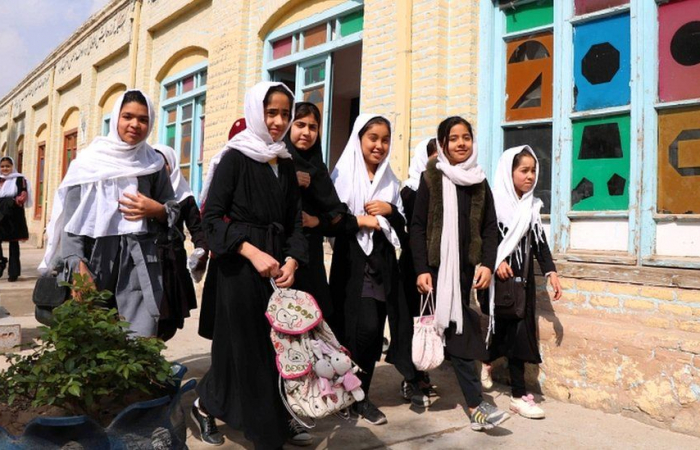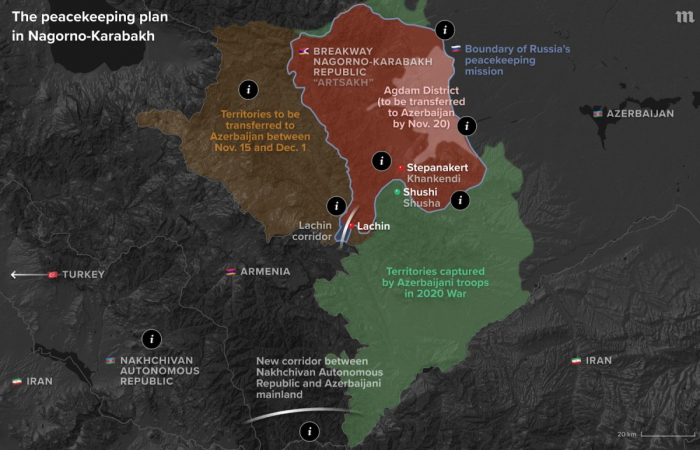For the first time in 31 years of the Armenia-Azerbaijan conflict, the situation feels more unpredictable than ever. In the past, there was a grim certainty that another war would erupt just as it did in September 2020 while peace, on the other hand, always seemed distant. In recent weeks, comments from U.S. President Donald Trump that it was almost a done deal simply solicited disagreement among analysts and political commentators. As if that wasn’t confusion enough, and although both Baku and Yerevan have said that the 10 July meeting between the leaders in Abu Dhabi was constructive, another issue has emerged unexpectedly to distract and deflect attention.
What began seemingly as speculation by a prominent U.S. think tank on 1 July now appears to be gaining traction. Washington might have proposed that an American company manage any transit route from Azerbaijan to Nakhchivan, running through Armenia, as envisaged by the November 2020 ceasefire statement. The situation was further muddled by the article in question appearing more focused on the need for Washington to push Ankara to open its border in the north.
However, the southern route, referred to as the “Zangezur Corridor” in Azerbaijan and Turkiye, would place the U.S. in direct proximity to Iran and Russian FSB border guards deployed in precisely the same area. Tehran has consistently warned that it will not tolerate any geopolitical changes on its border. The original article also suggested that an anonymous U.S. official opined that President Trump could win a Nobel Peace Prize if he helped facilitate the route.
This raised eyebrows given that several other ethnic Armenian commentators had pushed the same incentive of the coveted prize, though not guaranteed, since the beginning of June if he were to support Armenia’s position on unblocking regional communications. Again, the main focus was convincing or even pressuring Turkiye to open its border with Armenia before an agreement to normalise relations between Baku and Yerevan is signed. Ankara currently refuses to do so unless one is.
The articles also suggested that such a move could isolate Iran in the region, sideline Russia, and contain emerging Chinese ambitions. For many analysts in Armenia and Azerbaijan, this potential geopolitical escalation is precisely what the current bilateral track, suggested first by Baku in October 2023, sought to avoid. Since then there has reportedly been greater progress than earlier attempts by the EU, U.S., and Russia since 2021. All three had previously been criticised in the past.
Domestically, Pashinyan appears increasingly determined to remove the Russian FSB from the same route the U.S. would oversee. The recent move against Samvel Karapetyan, an Armenian-Russian oligarch, has also been seen similarly. Pashinyan threatened to nationalise the electricity distribution network the businessman controls. This echoed an idea offered by a Yerevan analyst over a year ago that nationalising the Armenia-Iran gas pipeline could wrest it from Moscow’s control.
A day after the Abu Dhabi summit, the U.S. Ambassador to Turkiye added to speculation by referring to a possible 100-year lease for an American company to manage the corridor, although he mistakingly put the length of the border at 32 kilometres. Pashinyan’s comments in a 16 July press conference did little to refute this narrative and appeared to confirm it. He neglected to mention any reciprocity in terms of a similar mechanism on Azerbaijani territory, however.
Armenia’s opposition quickly seized on the remarks, accusing Pashinyan of surrendering sovereignty, a charge made all the more damaging given his repeated assurances since 2020 that no such concession would occur.
Meanwhile, both Azerbaijan and Turkiye reportedly oppose the U.S. proposal. At the weekend, Azerbaijani President Ilham Aliyev reiterated that Baku expects unhindered transit through Armenia and that it will not permit a U.S. company to operate on its own territory. He further stated that Armenia would not become a transit country, likely a reference to Pashinyan’s ambiguous “Crossroads of Peace” proposal introduced as an alternative to Baku's “Zangezur Corridor.”
In parallel, pro-Pashinyan voices on social media have ramped up pressure on Washington, urging sanctions against Baku if it rejects the U.S. deal. They also continue to press the U.S. to pressure Ankara to open the Armenia-Turkiye border before the peace treaty is signed. Aliyev instead revealed that Baku prefers to initial the agreement until the two main sticking points are resolved – dissolving the OSCE Minsk Group and Armenia removing a controversial constitutional preamble.
Just to add to the confusion, at his press conference, Pashinyan claimed the idea of initialling the treaty was his while simultaneously avoiding answering clearly a question on whether he would. This is unfortunate given that normalisation is within reach. Probably, with elections around the corner, it is not close enough.
Some Armenian analysts also question whether such a corridor could realistically function, particularly in the absence of reciprocal guarantees or concrete economic benefits beyond infrastructure investment. Pashinyan has mentioned that any deal could also include laying electricity and communication cable, and has mentioned pipelines, perhaps in response. But as the terms of any U.S. deal remain unknown, including how long it would last, that is hardly an answer.
Moreover, there is little clarity on whether Washington intends to pursue this plan while other Armenian commentators suggest it is less about logistics and more about the U.S. taking on the role of a security guarantor, not unlike its recent deal with Ukraine on minerals. At least one Azerbaijani analyst believes this a trap set by Yerevan to sour Baku’s relations with Moscow further. But Kyiv already has the military backing of Brussels and Washington. Armenia is not as fortunate.
Last month, Israel followed by the U.S. launched airstrikes against Iran, highlighting how regional volatility could prove another spoiler if Tehran is not taken into account. That seems especially relevant on the proposed U.S. management of what is a geopolitically contested transit route that could spark regional fracture unless considered carefully. Though some offer the example of a 2011 deal between Russia and Georgia through Abkhazia as a precedent, that actually failed.
As one Azerbaijani host remarked in a panel discussion with an Armenian analyst recently, while the U.S. apparently speaks about the next 100 years, the South Caucasus doesn’t know what even the next six months will bring. The way the apparent U.S. proposal was presented has only confused the situation further. Replete with denial after contradiction until semi-confirmation, nobody seems to know for sure. When asked about the proposal last week, a senior U.S. State Department official simply told media they should approach the White House.






